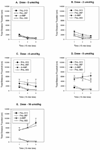Changes in feeding and locomotion induced by amphetamine analogs in rats
- PMID: 19062203
- PMCID: PMC2758604
- DOI: 10.1016/j.drugalcdep.2008.10.005
Changes in feeding and locomotion induced by amphetamine analogs in rats
Abstract
Studies of the biobehavioral actions of psychostimulants commonly focus on locomotion and less commonly on feeding, and only rarely are these measures considered in conjunction within the same animal. The present study compared the impact of (+)-amphetamine and three amphetamine analogs, PAL-287, PAL-313, and PAL-353, on eating and locomotion assessed concurrently using an automated activity/feeding chamber during a daily 45 min session. Each analog is a potent releaser of norepinephrine and of dopamine, but exerts differential serotonin-releasing activity (PAL-287>PAL-313>amphetamine>PAL-353). Rats were tested with each of five doses of drug (0, 2, 4, 8, or 16 micromol/kg, i.p.), given in equimolar concentrations and in random dose order. PAL-353, an analog with minimal serotonin-releasing capacity, markedly stimulated forward locomotion at 2, 4, 8 and 16 micromol/kg, as did amphetamine, whereas PAL-287 and PAL-313 did not. In contrast to the locomotor findings, all four amphetamine-like drugs exerted similar effects on the suppression of food intake. These results suggest that the capacity of an amphetamine analog (i.e. amphetamine and PAL-353) to stimulate serotonin release can diminish its psychostimulant action on locomotion, but does not reliably augment drug-induced hypophagia.
Figures



Similar articles
-
In vivo effects of amphetamine analogs reveal evidence for serotonergic inhibition of mesolimbic dopamine transmission in the rat.J Pharmacol Exp Ther. 2011 Apr;337(1):218-25. doi: 10.1124/jpet.110.176271. Epub 2011 Jan 12. J Pharmacol Exp Ther. 2011. PMID: 21228061 Free PMC article.
-
Concurrent measures of feeding and locomotion in rats.Physiol Behav. 2005 Apr 13;84(5):769-74. doi: 10.1016/j.physbeh.2005.03.006. Epub 2005 Apr 15. Physiol Behav. 2005. PMID: 15885254
-
Perinatal lead exposure alters locomotion induced by amphetamine analogs in rats.Life Sci. 2011 Mar 28;88(13-14):586-9. doi: 10.1016/j.lfs.2011.01.007. Epub 2011 Jan 21. Life Sci. 2011. PMID: 21256854 Free PMC article.
-
Effects of ICV administration of the alpha1A-adrenoceptor antagonist 5-methylurapidil on concurrent measures of eating and locomotion after cocaine in the rat.Life Sci. 2007 Sep 8;81(13):1059-65. doi: 10.1016/j.lfs.2007.08.004. Epub 2007 Aug 17. Life Sci. 2007. PMID: 17881010 Free PMC article.
-
5-HT2C receptors in the ventral tegmental area, but not in the arcuate nucleus, mediate the hypophagic and hypolocomotor effects of the selective 5-HT2C receptor agonist AR231630 in rats.Behav Brain Res. 2018 Jul 16;347:234-241. doi: 10.1016/j.bbr.2018.03.006. Epub 2018 Mar 17. Behav Brain Res. 2018. PMID: 29555337
Cited by
-
Light/dark phase-dependent spontaneous activity is maintained in dopamine-deficient mice.Mol Brain. 2017 Oct 16;10(1):49. doi: 10.1186/s13041-017-0329-4. Mol Brain. 2017. PMID: 29037208 Free PMC article.
-
In vivo effects of amphetamine analogs reveal evidence for serotonergic inhibition of mesolimbic dopamine transmission in the rat.J Pharmacol Exp Ther. 2011 Apr;337(1):218-25. doi: 10.1124/jpet.110.176271. Epub 2011 Jan 12. J Pharmacol Exp Ther. 2011. PMID: 21228061 Free PMC article.
-
Amphetamine reduces reward encoding and stabilizes neural dynamics in rat anterior cingulate cortex.Elife. 2020 Aug 19;9:e56755. doi: 10.7554/eLife.56755. Elife. 2020. PMID: 32812864 Free PMC article.
-
Computer Methods for Automatic Locomotion and Gesture Tracking in Mice and Small Animals for Neuroscience Applications: A Survey.Sensors (Basel). 2019 Jul 25;19(15):3274. doi: 10.3390/s19153274. Sensors (Basel). 2019. PMID: 31349617 Free PMC article. Review.
-
Ghrelin and ghrelin receptor modulation of psychostimulant action.Front Neurosci. 2013 Sep 25;7:171. doi: 10.3389/fnins.2013.00171. Front Neurosci. 2013. PMID: 24093007 Free PMC article. Review.
References
-
- Ator NA, Griffiths RR. Principles of drug abuse liability assessment in laboratory animals. Drug Alcohol Depend. 2003;70:S55–S72. - PubMed
-
- Baldo BA, Sadeghian K, Basso AM, Kelley AE. Effects of selective dopamine D1 or D2 receptor blockade within nucleus accumbens subregions on ingestive behavior and associated motor activity. Behavioural Brain Research. 2002;137:165–177. - PubMed
-
- Balopole DC, Hansult CD, Dorph D. Effect of cocaine on food intake in rats. Psychopharmacology. 1979;64:121–122. - PubMed
-
- Bardo MT, Bevins RA. Conditioned place preference: what does it add to our preclinical understanding of drug reward? Psychopharmacology. 2000;153:31–43. - PubMed
-
- Bassareo V, Di Chiara G. Differential responsiveness of dopamine transmission to food-stimuli in nucleus accumbens shell/core compartments. Neuroscience. 1999;89:637–641. - PubMed
Publication types
MeSH terms
Substances
Grants and funding
LinkOut - more resources
Full Text Sources

